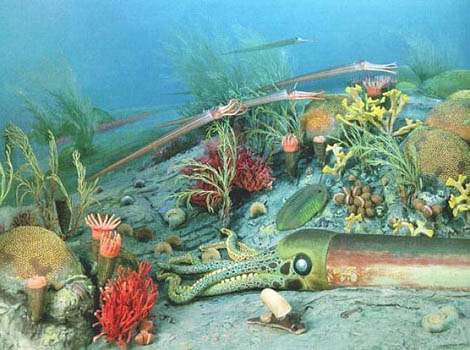 The evolution of life on Earth was marked by increased oxygen in the atmosphere and oceans.
The evolution of life on Earth was marked by increased oxygen in the atmosphere and oceans.
At the beginning of Earth's formation, 4,6 billion years ago, there was very little oxygen gas (molecular oxygen, O2).
The oxygen then existing was combined with other atoms, such as hydrogen, forming the water that hydrated the planet throughout its evolution.
And it was in an aquatic environment, in the waves of the primitive oceans, that the first forms of life emerged. The oldest fossil evidence of microorganisms is 3,6 billion years old. It doesn't mean that life didn't exist before. It means that either no traces have been left, or they have not yet been found. Those unicellular life forms belong to the group called cyanobacteria.
Primitive cyanobacteria had the ability to use sunlight as an energy source to carry out photosynthesis. Here, the oxygen present in the water molecules is combined to give rise to the oxygen molecule that diffuses through ocean waters and into the atmosphere. The increase in molecular oxygen, produced by the action of life, marked the evolution of life itself and changed the planet's chemistry.
There is geological evidence that shows how the oxygen concentration evolved in Earth's history. We know that the oxygen level in the atmosphere has not increased linearly. On the contrary, during the first 3 billion years after the start of its biogenic production, its concentration in the atmosphere remained residual.
But about 2,4 billion years ago what is called the first major oxygenation event (GOE) occurred and is characterized by a first but timid increase in atmospheric oxygen.
Oxygen, a product of life, was first combined with other substances, such as pyrite (FeS2), present on the ocean floor and on the surface of the earth's soils. In other words, this sequestration of oxygen by various substances, over billions of years, prevented it from being available to be used for the complexification of life.
And, in fact, there is a long evolutionary fast for about 3 billion years, with the emergence of few new forms of life, which remained mainly unicellular or living in colonies.
However, about 850 to 550 million years ago something changed on the planet and the oxygen concentration soared to about 31% in the atmosphere (10% more than today). And this oxidative shift was accompanied by an evolutionary explosion on the horizon of life.
In what is known as the Cambrian explosion, we see the emergence of a myriad of new expressions of very different living forms. All the ancestors of today's plants and animals arose in that explosion ignited by the sudden increase in free oxygen.
We don't know what caused this large increase in oxygen at a time called the second major oxygenation event. But geologists at the University of Tasmania, Australia, found that this moment was also accompanied by the increasing availability of other elements and materials for life in the oceans.
The results of the team led by Ross Large will be published in March in the magazine “Earth and Planetary Science Letters”.
Author Antonio Piedade
Science in the Regional Press – Ciência Viva


















Comments